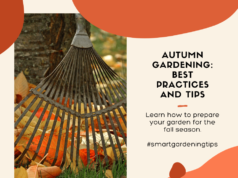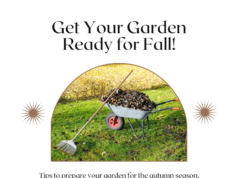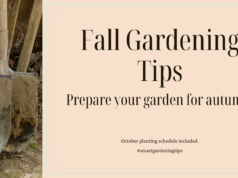
Welcome to our comprehensive guide on harvesting fall crops! As autumn approaches, it’s time to start planning for a successful and nourishing harvest season. Whether you’re new to gardening or a seasoned pro, we have expert advice to help you select, plant, and harvest the right fall crops.
Maximizing your autumn bounty begins with careful selection. Choosing the right fall crops tailored to your climate and garden conditions can ensure a bountiful harvest. From vibrant leafy greens to hearty root vegetables, we’ll share valuable tips to guide you in selecting the ideal crops for your garden.
Once you’ve selected your fall crops, it’s essential to prepare your garden for the upcoming harvest. Our detailed tips will walk you through the steps needed to create the optimal environment. From enriching the soil with organic matter to ensuring proper drainage, your garden will be ready to thrive.
As the temperatures drop, protecting your crops from frost and cold weather becomes crucial. We’ll provide you with effective techniques and tools to safeguard your plants. With our expert advice, you can confidently protect your harvest and overcome the chilly conditions.
When it’s time to reap the rewards of your hard work, knowing the optimal timing and techniques for harvesting fall crops is key. We’ll cover various types of crops, from delicious root vegetables to nutritious leafy greens. You’ll discover how to harvest your produce at its peak flavor and nutritional value.
Key Takeaways:
- Choose fall crops suitable for your garden and climate.
- Prepare your garden by enriching the soil and ensuring proper drainage.
- Protect your crops from frost and cold weather using effective techniques.
- Harvest your crops at the right time to enjoy the best flavor and nutrition.
- Extend your harvest season by exploring methods and tools to prolong crop yields.
With these expert tips, you’re well on your way to a successful and rewarding fall harvest. Stay tuned for more sections in our guide, where we’ll cover storing and preserving fall crops, as well as additional tips for proper storage. Start planning now and get ready for a season filled with the satisfaction of homegrown bounty!
Choosing the right fall crops to harvest
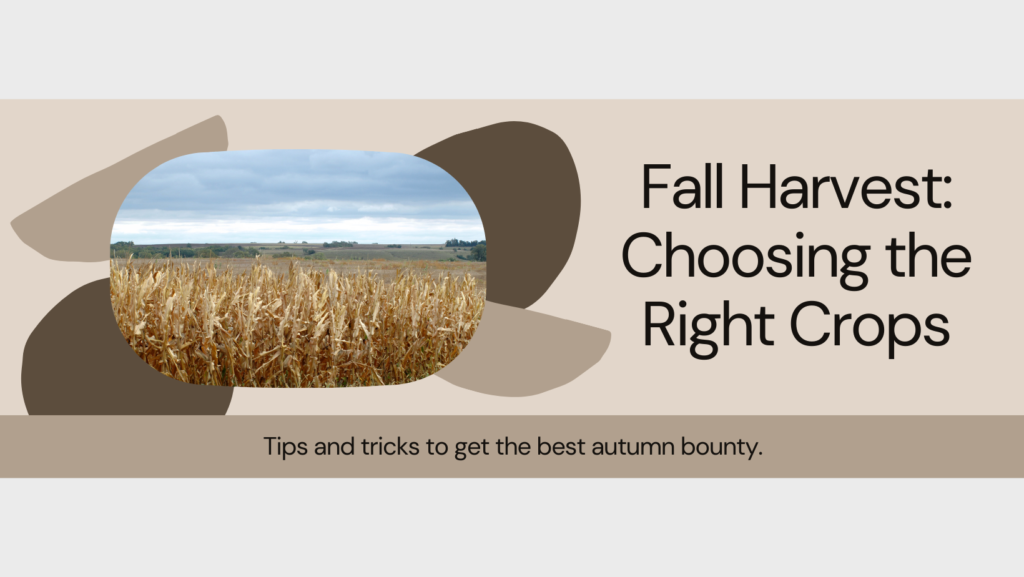
Before you start planting, it’s important to choose the right fall crops for your garden. The success of your harvest depends heavily on selecting crops that thrive during the fall season. Consider the following factors when choosing your fall crops:
- Suitability for your region: Different crops grow better in specific climates. Research which crops are most suitable for your region’s fall weather conditions.
- Growth requirements: Assess the sunlight, soil quality, and drainage capabilities of your garden. Choose crops that match these requirements for optimal growth.
- Maturity time: Determine the average length of your fall season. Select crops that can reach maturity within that timeframe to ensure a bountiful harvest.
- Variety and diversity: Aim for a diverse selection of fall crops to enhance your culinary experiences. Include a mix of root vegetables, leafy greens, and other seasonal favorites.
Once you’ve considered these factors, use the following tips to narrow down your choices and select the best fall crops for your garden:
- Research crop varieties: Look for varieties that are known for their success in the fall season. Seek recommendations from local experts, gardening forums, or seed catalogs.
- Consider crop rotation: Plan your fall crops based on the rotation cycle of your garden. Avoid planting the same crop family in the same spot to prevent nutrient depletion and disease build-up.
- Think about your preferences: Choose crops that you and your family enjoy eating. Harvesting crops that you love will make the gardening experience even more rewarding.
Remember, the key to a successful fall harvest lies in selecting crops that are well-suited to your growing conditions and personal preferences. By putting thought into your choices, you set yourself up for a delicious and abundant harvest.
“Choosing the right fall crops is like curating a gourmet menu for your garden. Selecting a diverse array of crops that thrive during autumn ensures a season filled with vibrant colors, rich flavors, and endless culinary possibilities.”
| Fall Crop | Best Suited For | Growth Time | Planting Tips |
|---|---|---|---|
| Carrots | Various climates | 60-80 days | Sow seeds directly in early fall for a continuous harvest. Loosen soil to accommodate long roots. |
| Kale | Cooler climates | 50-75 days | Plant in late summer for a fall harvest. Protect from frost with row covers. |
| Pumpkins | Warmer climates | 75-100 days | Start seeds indoors in early summer, then transplant outside after the risk of frost has passed. |
Preparing your garden for fall harvest
As the fall harvest season approaches, it’s important to prepare your garden for optimum growth and yield. By following these essential preparation tips, you can create the ideal environment for your fall crops to thrive and ensure a bountiful harvest.
1. Clear Out the Old
Before you start preparing your garden for fall crops, remove any remaining summer plants that have stopped producing or are past their prime. Clearing out the old plants will make space and prevent the spread of diseases to new crops.
2. Assess Soil Quality
Healthy soil is the foundation for a successful fall harvest. Test the soil pH and amend it if necessary to create the optimal conditions for your crops. Add organic matter such as compost or well-rotted manure to improve soil fertility and structure.
3. Weed Control
Eliminate weeds that may compete with your fall crops for nutrients, water, and sunlight. Regularly remove weeds or use organic weed control methods to keep your garden free from unwanted vegetation.
4. Improve Drainage
Ensure proper drainage in your garden to prevent waterlogging and root rot. Clear any debris or excess mulch that may hinder drainage and consider adding organic matter or improving the slope of your garden beds if necessary.
5. Consider Crop Rotation
Implement crop rotation to minimize the risk of disease and pests. Avoid planting the same family of crops in the same location year after year. Instead, rotate crops to different areas of your garden to break the pest and disease cycle.
6. Plan Your Planting
Plan your fall garden layout by considering the spacing requirements and companionship of different crops. Research companion planting to maximize yields, deter pests, and promote healthy growth.
7. Protect Against Pests
Take preventive measures to protect your fall crops from common garden pests. Use physical barriers, such as row covers or netting, to deter insects and birds from feasting on your harvest. Additionally, be vigilant in scouting for pests and be prepared to use organic pest control methods if necessary.
8. Provide Adequate Watering
Water your fall crops consistently, ensuring the soil remains consistently moist but not waterlogged. Adjust watering schedules based on weather conditions and the specific needs of each crop.
9. Consider Season Extension
If you live in an area with a shorter growing season, consider using season extension techniques, such as cold frames or row covers. These methods can protect your crops from early frosts and extend the harvest period.
10. Maintain Regular Maintenance
Throughout the fall season, continue to provide regular care and maintenance for your garden. This includes monitoring for pests and diseases, weeding, and providing support for crops that require it.
By taking the time to properly prepare your garden for the fall harvest, you’ll set the stage for a successful and abundant yield. Follow these essential tips to ensure that your fall crops thrive and that you reap the rewards of a fruitful garden.
Protecting crops from frost and cold weather
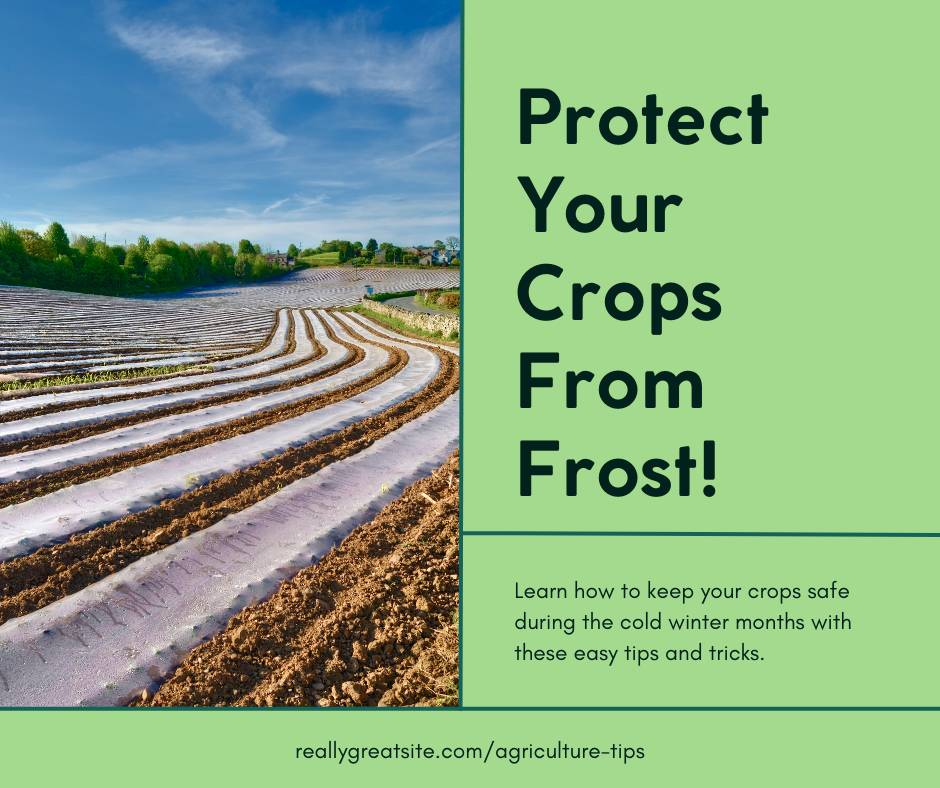
As the temperatures drop, it’s essential to take proactive measures to protect your fall crops from the detrimental effects of frost and cold weather. Without proper protection, frost can damage and even kill your plants, resulting in a failed harvest. By implementing effective techniques and utilizing the right tools, you can safeguard your crops and ensure their survival during the chilly conditions.
Here are some strategies to help you protect your crops from frost and cold weather:
1. Covering your crops
One of the most effective ways to shield your plants from frost is by covering them with protective materials. Row covers, frost blankets, or even old bedsheets can provide a barrier against the cold temperatures. Make sure to secure the coverings to prevent them from being blown away by strong winds. Remember to uncover the plants during the day to allow sunlight and air circulation.
2. Utilizing mulch
Mulching around your plants can help insulate the soil and protect the roots from freezing temperatures. Apply a layer of organic mulch, such as straw or shredded leaves, around the base of the plants. Mulch acts as a natural insulator, maintaining a more stable soil temperature and reducing the risk of frost damage to the roots.
3. Watering your plants
Water acts as a thermal regulator and can help protect your plants from frost. Before a frosty night, water the soil thoroughly but avoid soaking the foliage. The moist soil will absorb and retain heat during the night, raising the temperature around the plants. However, be cautious not to overwater, as waterlogged soil can lead to root rot or other issues.
4. Using cold frames or hoop houses
Cold frames and hoop houses are structures designed to provide a controlled environment for your plants. They can be constructed using transparent materials like plastic or glass, allowing sunlight to enter and trapping heat inside. These structures offer an extra layer of insulation and protection against frost and cold weather.
“Proper protection against frost and cold weather is crucial to ensure the success of your fall crop harvest.” – Yourname, Expert Gardener
Implementing these protective measures can greatly increase the chances of a successful harvest, even in frost-prone regions. Don’t let the cold weather hinder your gardening efforts; take the necessary steps to protect your crops and enjoy a bountiful autumn harvest.
| Techniques for Protecting Crops from Frost and Cold Weather | Advantages |
|---|---|
| Covering crops | Provides a physical barrier against frost |
| Utilizing mulch | Insulates the soil and protects roots |
| Watering plants | Helps regulate temperature and prevent frost damage |
| Using cold frames or hoop houses | Creates a controlled environment with added insulation |
Harvesting techniques for fall crops

When it comes to reaping the rewards of your fall crops, timing and harvesting techniques are essential for ensuring peak flavor and nutritional value. Below, we’ll guide you through some key tips and methods for harvesting various types of fall crops, from root vegetables to leafy greens.
Timing is everything
Knowing the right time to harvest your fall crops is crucial. Different crops have different maturation rates, so keep an eye on their growth and consult the seed packets or plant labels for approximate harvest dates. Most fall crops are ready to be harvested when they have reached their full size and color.
Root vegetables
Root vegetables, such as carrots, beets, and radishes, can be harvested when the tops of the vegetables start to protrude from the soil. Gently loosen the soil around the base of the plant and pull the vegetable out, taking care not to damage the roots. Remove the leaves and store the vegetables in a cool, dark place to preserve their freshness.
Leafy greens
Leafy greens, like kale, spinach, and lettuce, can be harvested by simply cutting off the outer leaves as needed. This method allows the inner leaves to continue growing, providing you with a continuous supply of fresh greens throughout the season. Remember to wash the leaves thoroughly before consuming.
“Harvesting your fall crops at the right time ensures that you enjoy the best flavors and nutritional benefits. Don’t rush the process, and you’ll be rewarded with a bountiful harvest.”
Herbs
When it comes to harvesting herbs, it’s best to do so before they flower. Snip off the leaves or stems near the base of the plant, ensuring that you leave enough foliage for the plant to continue growing. Fresh herbs can be used immediately, while leftover herbs can be dried or stored in the refrigerator for later use.
Harvesting Tips for Fall Crops
| Crop | Harvesting Method |
|---|---|
| Carrots | Gently pull out from the soil when tops protrude |
| Kale | Remove outer leaves as needed, allowing inner leaves to grow |
| Pumpkins | Wait until the stems turn brown and dry, then cut off from the vine |
| Broccoli | Harvest the central head when it is firm and tight, leaving the side shoots to continue growing |
Proper handling and storage
After harvesting your fall crops, it’s important to handle them with care to avoid bruising or damage. Remove any excess dirt, trim off any damaged parts, and store them in a cool, dry place. Some crops, like winter squash, can be stored for months if kept in ideal conditions.
By following these harvesting techniques, you can make the most of your fall crops, enjoying their freshness and nutritional value. Remember, each crop may require specific harvesting methods, so always consult reliable gardening resources or seek advice from experienced gardeners to maximize your yield.
Extending your harvest season
So you’ve successfully planted and cultivated your fall crops, and now you want to savor the flavors of the harvest season for as long as possible. Good news! There are several methods you can employ to extend your harvest season and continue enjoying fresh, homegrown produce. Let’s explore some tools and techniques that can help you prolong your crop yields.
Row Covers
One effective way to protect your fall crops from the chilling temperatures is by using row covers. These lightweight fabric covers act as a shield, protecting your plants from frost and cold weather. Row covers are easy to install and can extend your harvest season by a few weeks. They also provide an added benefit of warding off pests and keeping your crops disease-free.
Cold Frames
A cold frame is a mini greenhouse that helps create a warmer microclimate for your plants. Constructed with transparent material, such as glass or plastic, a cold frame traps heat from the sun, keeping the temperature inside higher than the surrounding environment. This allows you to grow more delicate crops well into the fall and even winter. Cold frames are particularly useful for extending the growing season of herbs and salad greens.
Succession Planting
Another clever technique for extending your harvest season is succession planting. Instead of sowing all your seeds at once, stagger your plantings by a few weeks. This way, you’ll have a continuous supply of fresh produce throughout the season. As you harvest the mature plants, new seedlings will be ready to take their place, ensuring a continuous harvest well into the fall.
Preservation Techniques
While the above methods help you extend your harvest season in the garden, there are also preservation techniques you can employ to enjoy your homegrown goodness even after the growing season ends. Consider canning, freezing, or dehydrating your surplus crops to enjoy them throughout the year. These methods allow you to lock in the flavors and nutritional benefits of your fall crops for long-term enjoyment.
By leveraging these tools and techniques, you can make the most of your fall harvest and continue relishing the taste of fresh produce even as the weather cools down. The joy of growing your own food extends well beyond the traditional summer months, thanks to these strategies that allow you to savor the deliciousness of fall crops for longer durations.
Storing and preserving fall crops
Once you’ve harvested your bountiful fall crops, it’s crucial to store and preserve them properly to maintain their freshness and flavors. With the right techniques, you can enjoy the fruits and vegetables of your labor long after the harvest season. Follow these essential tips for storing different types of crops and learn preservation methods that will keep your harvest at its best.
Proper Storage Techniques
Each type of fall crop requires specific storage conditions to ensure its longevity and quality. Here are some guidelines:
| Fall Crop | Storage Tips |
|---|---|
| Root Vegetables (e.g., carrots, potatoes) | Store in a cool, dark place with a temperature range of 32°F to 40°F (0°C to 4°C). Remove any greens and keep the roots dry. |
| Squash and Pumpkins | Store in a dry, well-ventilated area with a temperature range of 50°F to 55°F (10°C to 13°C). Avoid stacking them to prevent bruising. |
| Leafy Greens (e.g., kale, spinach) | Remove any damaged leaves and wash them thoroughly before storing. Wrap them in damp paper towels and place them in a perforated plastic bag in the refrigerator. |
| Herbs | Place herbs in a glass of water, cover them loosely with a plastic bag, and store them in the refrigerator. Alternatively, you can freeze herbs in ice cube trays with water or oil. |
| Apples and Pears | Store in a cool, humid environment with a temperature range of 30°F to 35°F (-1°C to 2°C) and high humidity. Check regularly for any signs of spoilage. |
Preservation Methods
In addition to proper storage, you can use preservation methods to extend the shelf life of your fall harvest:
- Canning: Preserve fruits and vegetables by canning them in jars. This method involves preserving them in a liquid, such as syrup or brine, and sealing the jars to create a vacuum.
- Freezing: Many fall crops can be blanched and frozen to maintain their flavors and textures. Label and date each item before placing them in the freezer for easy identification.
- Drying: Herbs, peppers, and some fruits can be dried to enhance their shelf life. Use a dehydrator or oven with low heat to remove moisture.
- Pickling: Turn your excess fall produce into tangy pickles by preserving them in a mixture of vinegar, water, salt, and spices. Experiment with different flavors and combinations!
Remember, the quality of your stored crops will depend on the initial quality at harvest. To ensure the best results, choose healthy, undamaged produce, and handle it with care during the harvesting process.
By storing and preserving your fall crops properly, you can savor the flavors of the harvest season throughout the year. Whether you’re enjoying fresh roots in the depths of winter or savoring homemade pickles on a summer picnic, your preserved crops will bring a taste of autumn to any occasion.
Tips for proper storage of fall crops
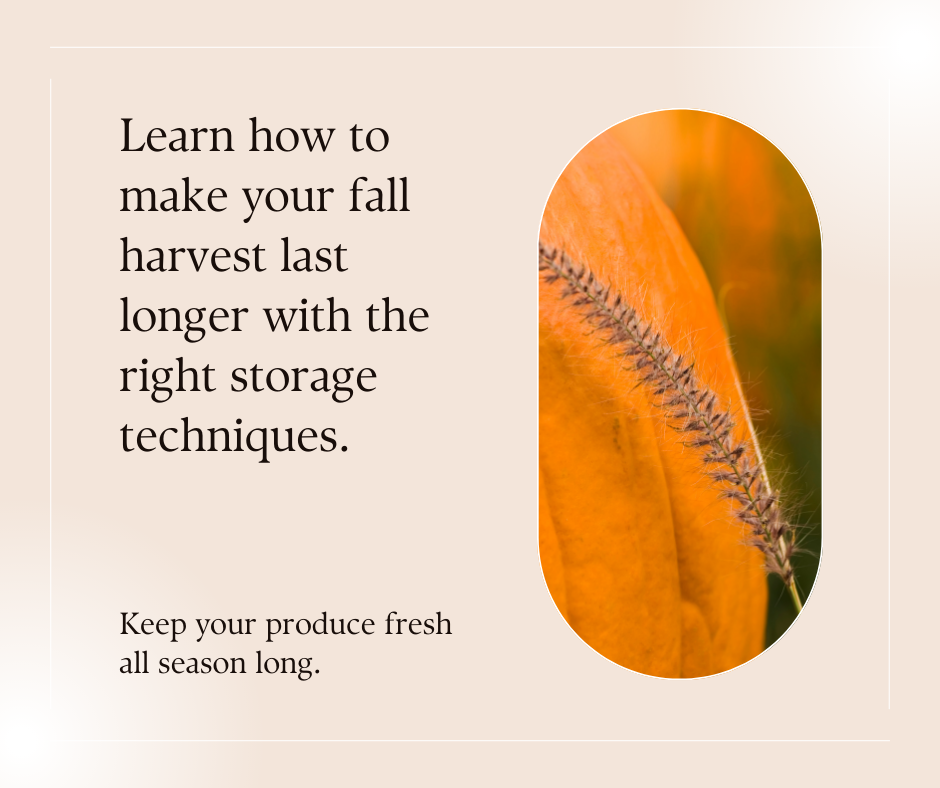
When it comes to maximizing the freshness and longevity of your fall crops, proper storage is key. Follow these expert tips to ensure that your harvested produce stays in top condition for as long as possible.
1. Control Temperature and Humidity
Temperature and humidity levels play a crucial role in the storage of fall crops. Most crops prefer cool temperatures and high humidity to maintain their freshness. Consider storing your produce in a root cellar or a cool basement where the temperature ranges between 32°F (0°C) and 50°F (10°C) with humidity levels around 85-90%. If these options are not available, you can also use a refrigerator, adjusting the humidity settings if possible.
2. Choose the Right Packaging
Proper packaging is essential for preserving the quality of your fall crops. Opt for breathable storage containers, such as mesh bags or perforated plastic bags, to allow air circulation and prevent moisture buildup. Avoid using airtight containers as they can cause condensation and accelerate spoilage. Remember to remove any excess dirt or debris from your crops before storing them to prevent rotting.
3. Sort and Separate
Sorting and separating your fall crops before storage can help extend their shelf life. Remove any damaged, bruised, or rotting vegetables and separate them from the healthy ones. This prevents the spread of spoilage and ensures that only the best-quality produce is stored together. It’s also a good practice to regularly check your stored crops for any signs of deterioration and remove any affected ones promptly.
4. Take Advantage of Natural Storage Options
If you have access to outdoor space, consider utilizing natural storage options for certain fall crops. For example, root vegetables like carrots, beets, and turnips can be stored in the ground. To protect them from freezing, cover the vegetables with a thick layer of straw or leaves, ensuring they remain insulated throughout the winter. This method can help keep your crops fresh and easily accessible, even during the colder months.
5. Monitor and Rotate
Regularly monitor your stored fall crops and inspect them for any signs of spoilage. Rotating the crops by using the “first in, first out” principle ensures that older produce is used first, reducing waste. Additionally, keeping an inventory of your stored crops can help you plan your meals and prevent any unutilized produce from going bad.
By implementing these tips, you can extend the shelf life of your fall crops and enjoy their freshness well into the colder months. With proper storage, you’ll have a bountiful harvest that lasts for as long as possible.
FAQ
Q. How do I choose the right fall crops to harvest?
A. When selecting fall crops, consider factors such as the specific climate and growing conditions in your area, as well as your personal preferences and gardening goals. Research which crops are known to thrive during the fall season and choose varieties that are suitable for your region. Additionally, consider the space available in your garden and the amount of time it takes for certain crops to mature.
Q. How should I prepare my garden for fall harvest?
A. To prepare your garden for fall harvest, start by clearing away any debris or spent plants from the previous season. Remove weeds and amend the soil with organic matter to provide the necessary nutrients for your fall crops. Test the soil pH and make any necessary adjustments. Ensure proper drainage by amending heavy clay soils. Finally, consider installing row covers or protective structures to shield your crops from cold temperatures and frost.
Q. How can I protect my fall crops from frost and cold weather?
A. To protect your fall crops from frost and cold weather, consider using various methods such as row covers, cloches, or cold frames. These structures help to create a microclimate and provide insulation for your plants. Additionally, monitor weather forecasts and be prepared to cover your crops with blankets or tarps if freezing temperatures are expected. Watering the soil before a frost can also help insulate plant roots and protect them from the cold.
Q. What are some harvesting techniques for fall crops?
A. The timing of the harvest depends on the specific crop and its maturity requirements. Generally, it’s best to harvest fall crops in the morning when the temperature is cooler. Use sharp pruners or shears to harvest leafy greens, cutting the outer leaves and leaving the center intact for continued growth. For root vegetables, gently loosen the soil around the base of the plant and lift them out. Carefully handle delicate crops like tomatoes, harvesting them when they are fully ripe but before the first frost.
Q. How can I extend my harvest season for fall crops?
A. To extend your harvest season, consider utilizing techniques such as succession planting, where you sow seeds in intervals to ensure a continuous supply of crops. Another method is to grow cold-tolerant varieties or utilize season-extension tools like hoop houses or greenhouses. Additionally, cover crops can be used to protect the soil and provide additional harvest opportunities in the form of edible greens or as a source of organic matter for the next growing season.
Q. How should I store and preserve my fall crops?
A. Proper storage and preservation methods are essential for maintaining the freshness and flavor of your fall crops. A cool, dark, and dry location is ideal for storing root vegetables, while leafy greens can be stored in the refrigerator’s crisper drawer. Some crops, like apples, pears, and winter squash, can be stored in a cool basement or garage. Preservation methods such as canning, freezing, drying, or fermenting can be used to extend the shelf life of various fall crops.
Q. What are some tips for proper storage of fall crops?
A. Ensure your fall crops stay fresh by following these tips for proper storage: – Clean and dry the produce before storing it to prevent mold and decay. – Remove any damaged or diseased parts of the crops to prevent them from spreading. – Store different crops separately to avoid ripening or decay of nearby produce. – Monitor the stored crops periodically and remove any spoiling ones to prevent contamination. – Use appropriate containers or packaging, such as breathable bags or ventilated storage bins, to maintain optimal humidity levels. – Adjust the temperature and humidity of the storage area according to the specific requirements of each crop.
Q. How can I make the most of my fall harvest?
A. To maximize your fall harvest, it’s important to plan ahead and make use of various strategies: – Practice crop rotation each year to optimize soil health and reduce the risk of pests and diseases. – Preserve excess produce through canning, freezing, or drying so that you can enjoy garden-fresh flavors throughout the year. – Consider sharing your bounty with friends, family, or local food banks. – Save seeds from your best-performing plants to use for future planting. – Keep a garden journal to record successes and challenges, allowing for continuous improvement in your gardening practices.
Conclusion
Congratulations! By following the expert advice in this article, you are well-equipped to have a successful and nourishing fall harvest season. The careful selection, planting, and harvesting of your chosen fall crops will ensure a bountiful yield that can be enjoyed for months to come.
Remember, the key to a successful harvest is proper storage and preservation. Take the time to learn the best methods for storing your fall crops, as this will help maintain their freshness and flavor. Whether you’re storing root vegetables, leafy greens, or other fall favorites, proper storage is essential for extended enjoyment.
Preserving your fall crops is another great way to make the most of your harvest season. Whether you prefer canning, freezing, or dehydrating, there are various preservation methods to choose from. Explore different techniques and recipes to find the ones that best suit your preferences and the crops you’ve harvested.
As you embark on this fall harvest journey, don’t forget to savor the fruits (and vegetables!) of your labor. The joy of a successful harvest season lies not only in the nourishing and delicious produce but also in the satisfaction of knowing that you have played a vital role in growing your own food. Enjoy the flavors of fall and the rewards of a fruitful harvest!


